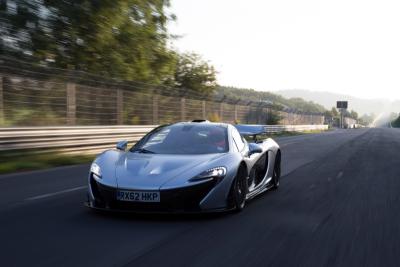Sub-seven around the 'Ring: a driver's eye view
McLaren's sensational new P1 supercar completed its development objectives by lapping the fearsome Nurburgring Nordschleife in under seven minutes, but how was it done? Read on for an account of the achievement by the man behind the wheel...
"The Supernova Silver example of the McLaren P1, codenamed XP2R, was driven the 390 miles from Woking across to the N?rburgring ahead of this final development test phase, underlining the car's unique road-to-race ability. On arrival at the track, 'Race' mode extended the active rear wing by 300mm, dropped the ride height by 50mm and saw the RaceActive Chassis Control suspension system stiffen by 300 per cent - a fully-focused track car at the push of a button.
The P1 generates up to 600kgs of downforce through the use of advanced active a
erodynamics which, in conjunction with the bespoke tyres, provides unprecedented levels of grip and superior balance and handling. This allows the McLaren to carry greater levels of speed through the corners, and achieve higher apex speeds, and the optimised traction enables the driver to get on the power earlier.
"The track is like the rollercoaster from hell," explains test driver Chris Goodwin, "However, the car feels balanced and poised throughout, and inspires you to push on with the levels of grip and all-round ability.
"The acceleration from the Aremberg right hander down the Fuchsr?hre is absolutely amazing. I have only experienced acceleration like this before in an F1 car. This downhill snaking section of the track is taken flat, using DRS, shifting gear all the way down to the base of the valley, and the compression that follows applies the maximum vertical g-forces to the car. The forces really load the tyres, chassis and wing, but it is taken with only a slight lift of the throttle.
"The numerous jumps that make the Nordschleife famous are an even bigger challenge than normal with the massive speeds we approach them. Flugplatz and Pflanzgarten are both taken at very high speed, but the levels of downforce generated combats these approach speeds, and keep the car really stable on 'landing'. They are both quite scary corners in any car, but I've never felt as confident. It's just sensational.
"Through Bergwerk [the corner at which Niki Lauda had his infamous accident in the 1976 German GP], you have to turn in late in order to carry as much speed as you can onto the following straight without running wide. Here, the awesome braking and pin-sharp steering of the P1 were crucial, enabling me to get back on the throttle smoothly and quickly. That is a quick section, and one that feels fantastic when you get it just right."
Immediately back on the pace on the exit of Bergwerk, the groundbreaking RaceActive Chassis Control (RCC) ensures the McLaren remains planted and balanced through a particularly bumpy section of track.#
"With a car this fast, stability is just as important as ultimate grip, and some of the bumpiest sections of the track are also the fastest," Goodwin continues, "The relentless climb towards the Karussell is dealt with in a few spectacular moments as the full combined power of the powertrain punches the car up this long incline. At the top of the hill is one of the fastest corners on the lap, with a approach speed around 300 km/h, The track is really bumpy here, but the corner is dispatched with a light dab of the brakes in fifth gear."
Cornering forces peak as the McLaren drops onto the banked concrete surface at the Karussell, and swings round more than 180 degrees. In terms of pure lateral g-forces, the driver is subjected to 3.9g.
From here, the car enters the final stages of the lap, and the sprint to the finish. Running on road-legal tyres specially developed by Pirelli, the production-specification model set a relentless pace, peaking at the electronically limited 330 km/h (205 mph) available in 'Race' mode on the D?ttinger H?he straight.
Throughout the course of a single lap, a gear change was made, on average, every six seconds and, unlike in F1 where DRS is limited to one or maybe two designated zones to aid overtaking, the system was used for nine per cent of the entire lap on seven separate occasions as Goodwin made his way towards the finish line. The system is operated through the steering wheel-mounted button, and trims the twin element rear wing from 29? to 0?. When engaged, the use of DRS reduces downforce on the car by 60 per cent.
"The D?ttinger H?he straight disappears in no time," Goodwin reveals, "From Galgenkopf, the acceleration is brutal, but when you press the DRS button, it ramps up even further as the car slips through the air, and you arrive at the limited top speed of 330 kph in no time. And then, the car just sits there, cruising at this surreal speed, with the rough tarmac and Eifel mountain scenery flying by as if it's a movie on fast forward."
Having driven the full range of McLaren road and race cars, Goodwin is in a unique position to comment on the performance characteristics and abilities, and how the P1 compares.
"Driving the P1 at this pace, on this circuit, is the most impressive driving experience I've ever had in any road or race McLaren, on any road or track in the world," he concluded following his sub 420-second sprint around one of the world's most fearsome circuits.


![Johann Zarco, LCR, Honda RC213V, 2024 San Marino MotoGP, Misano, action [Gold & Goose]](https://cdn.crash.net/styles/thumbnail/s3/2024-09/GnG_1166323_HiRes.jpg?itok=vpgrU7Q4)

![Jack Miller, KTM Factory Racing, KTM RC16, San Marino MotoGP, Misano, action [Gold & Goose]](https://cdn.crash.net/styles/thumbnail/s3/2024-09/GnG_1167624_HiRes.jpg?itok=iz7mA4EQ)


![Fabio Quartararo, Monster Energy Yamaha Racing, Yamaha M1, 2024 MotoGP, Misano Test, action [Gold & Goose]](https://cdn.crash.net/styles/thumbnail/s3/2024-09/GnG_1168928_HiRes.jpg?itok=fcYSole_)
![Toprak Razgatlioglu, ROKiT BMW Motorrad, BMW M 1000 RR, Magny-Cours, WorldSBK [Gold & Goose]](https://cdn.crash.net/styles/thumbnail/s3/2024-09/GnG_1165133_HiRes.jpg?itok=GD5SVNVG)

